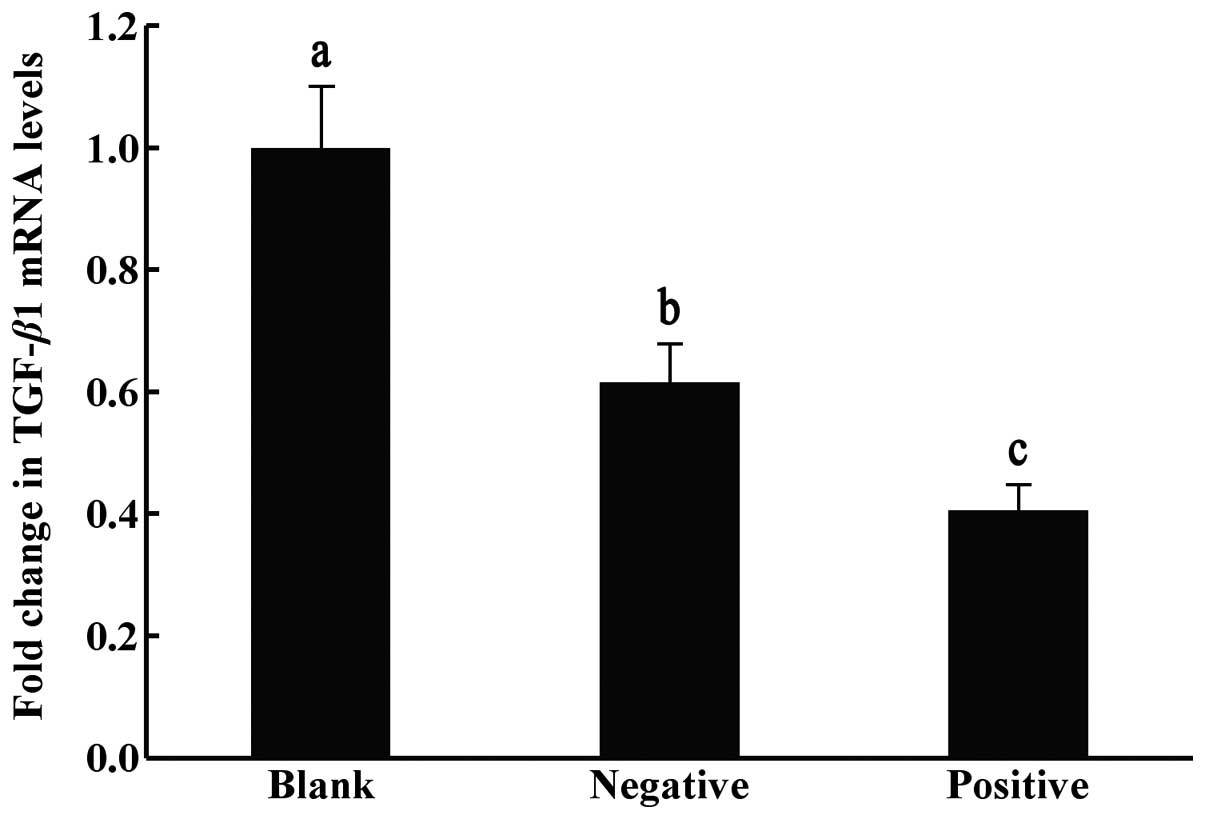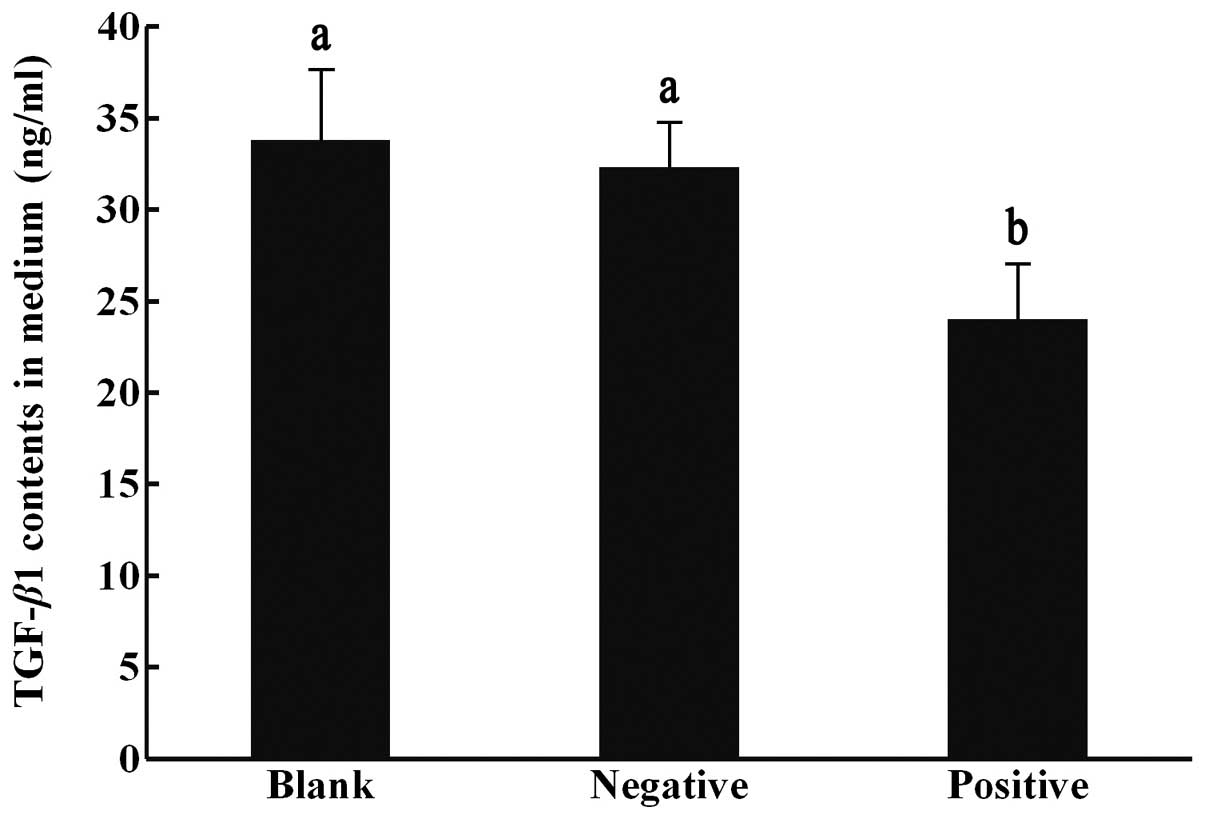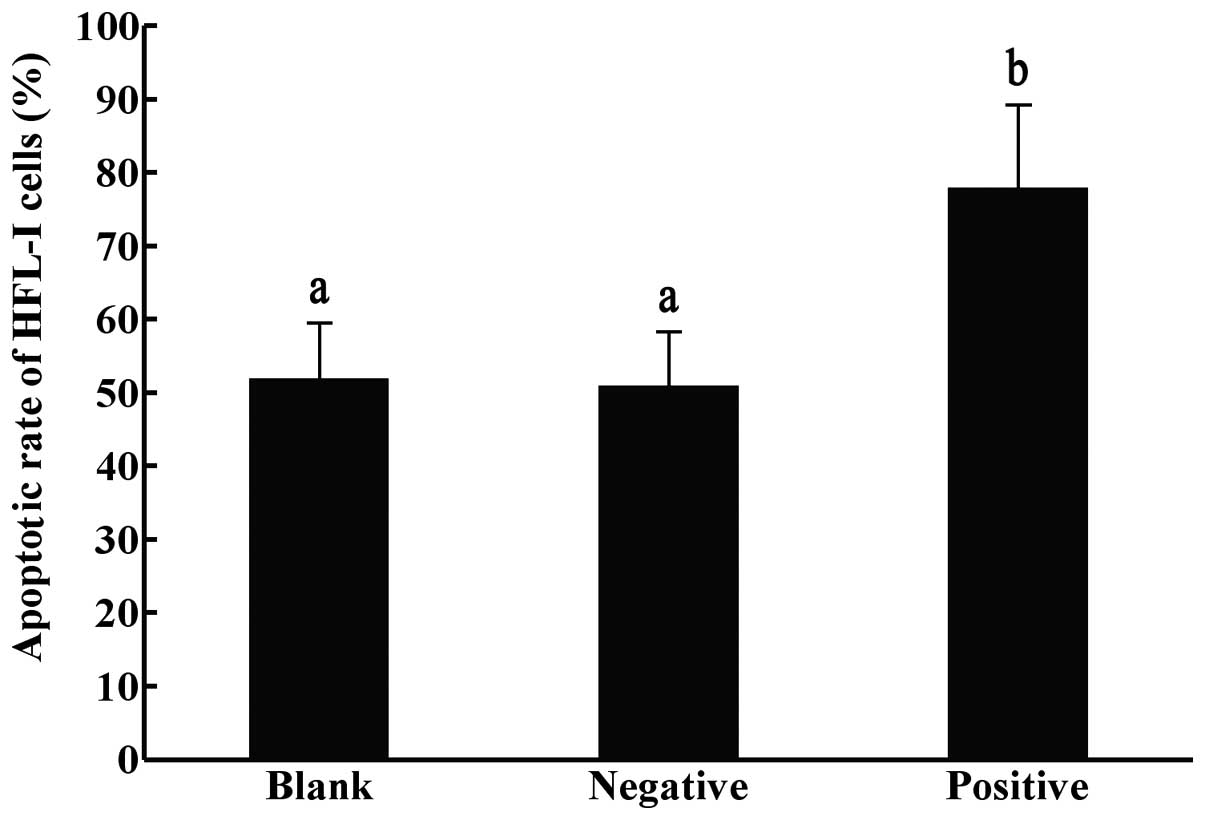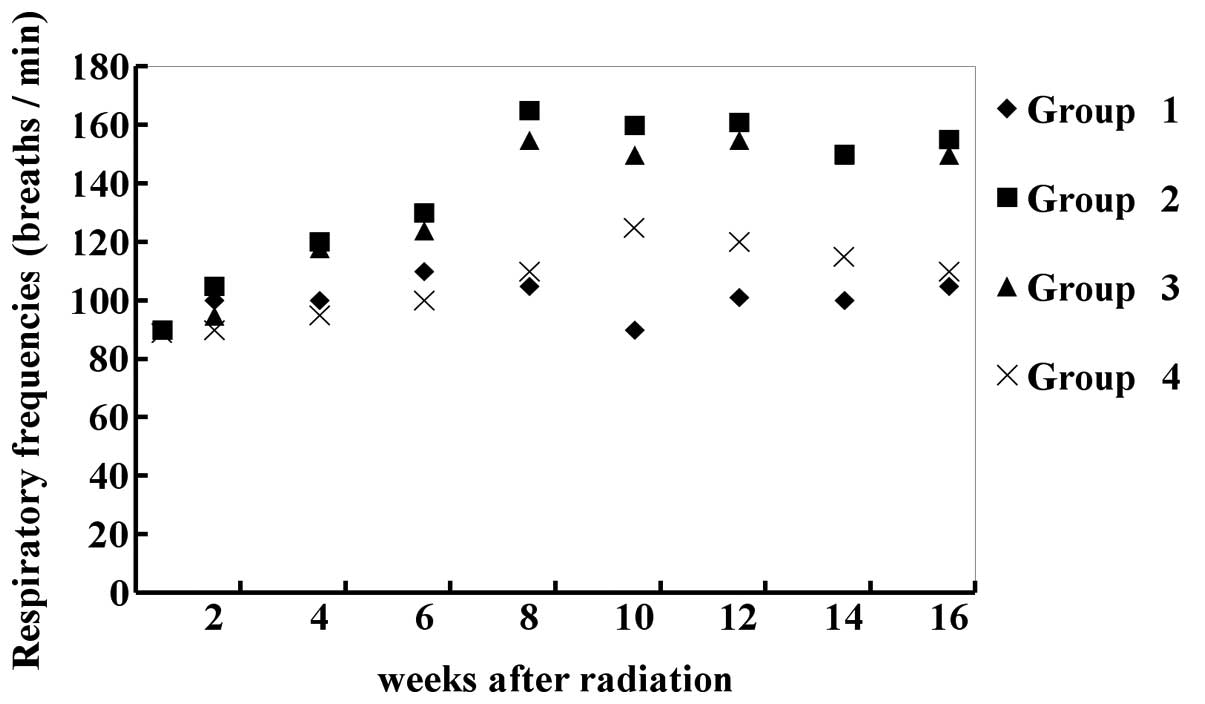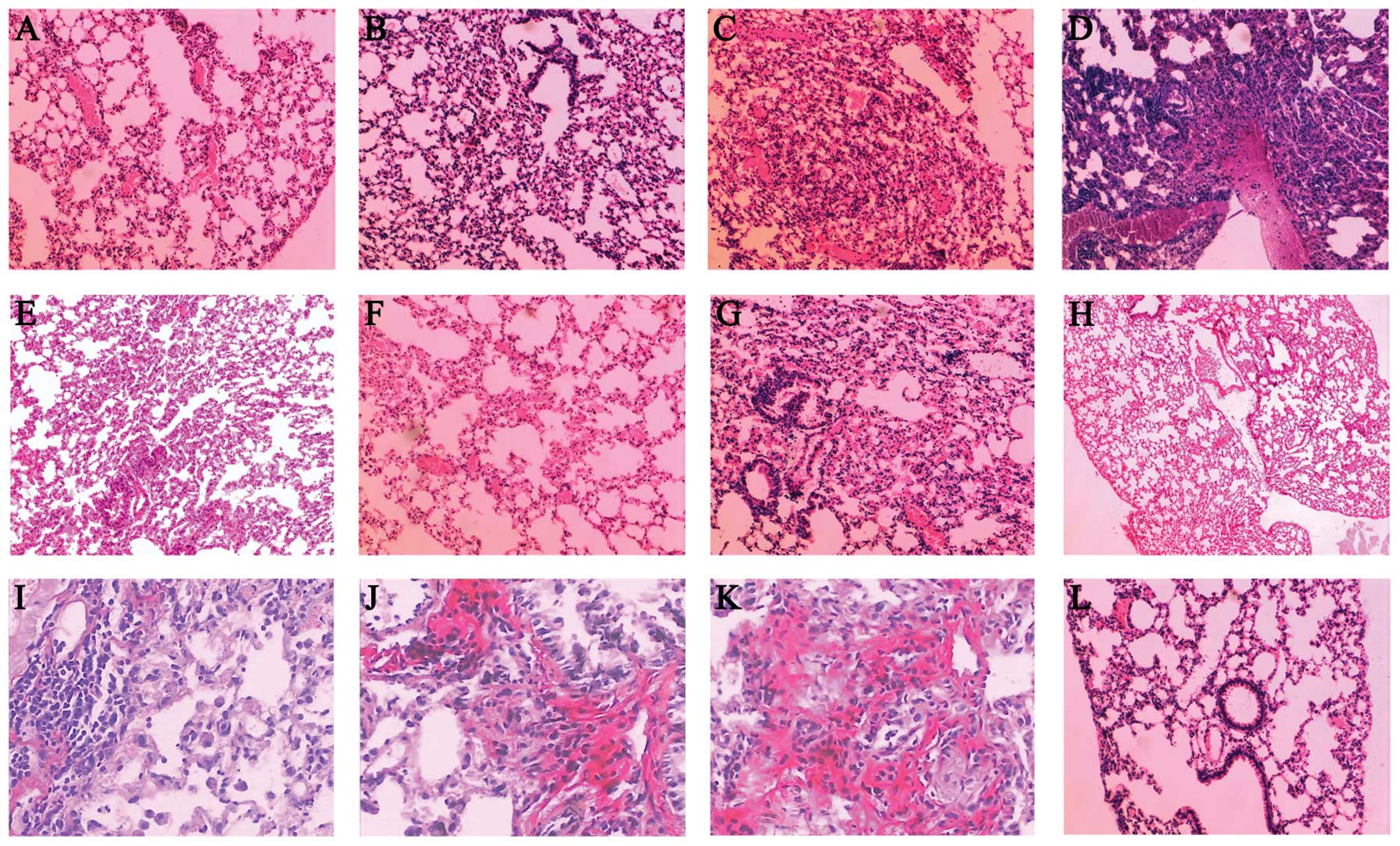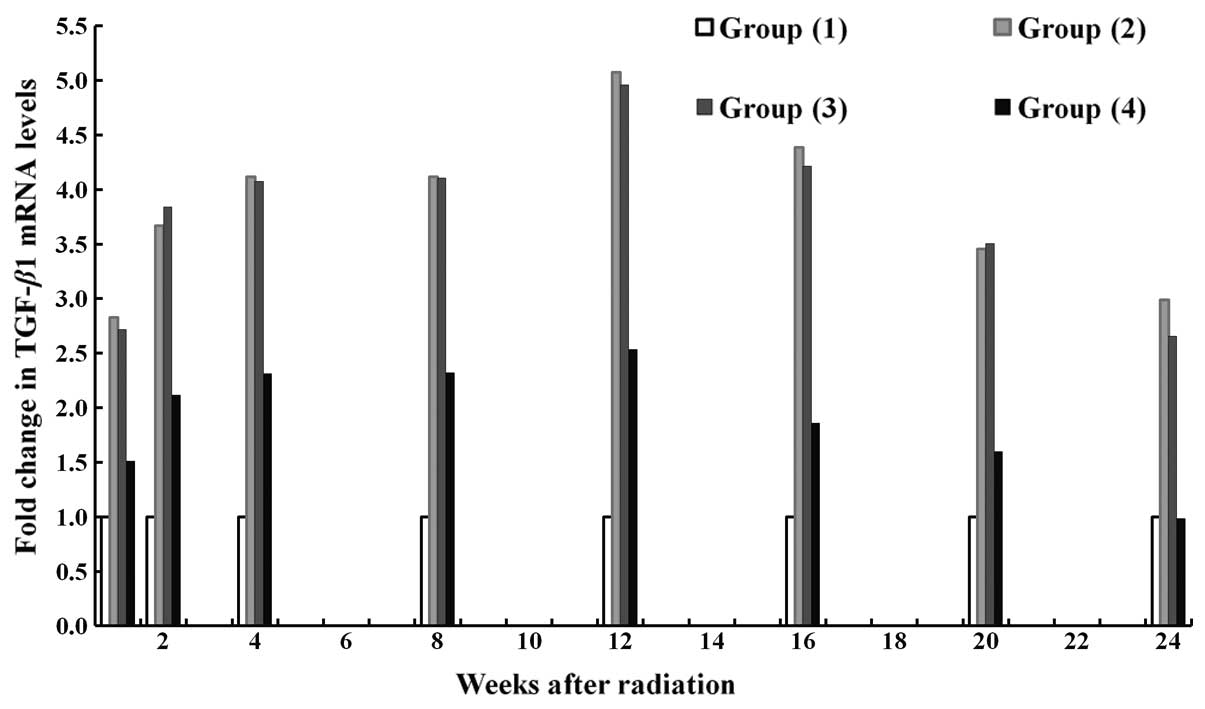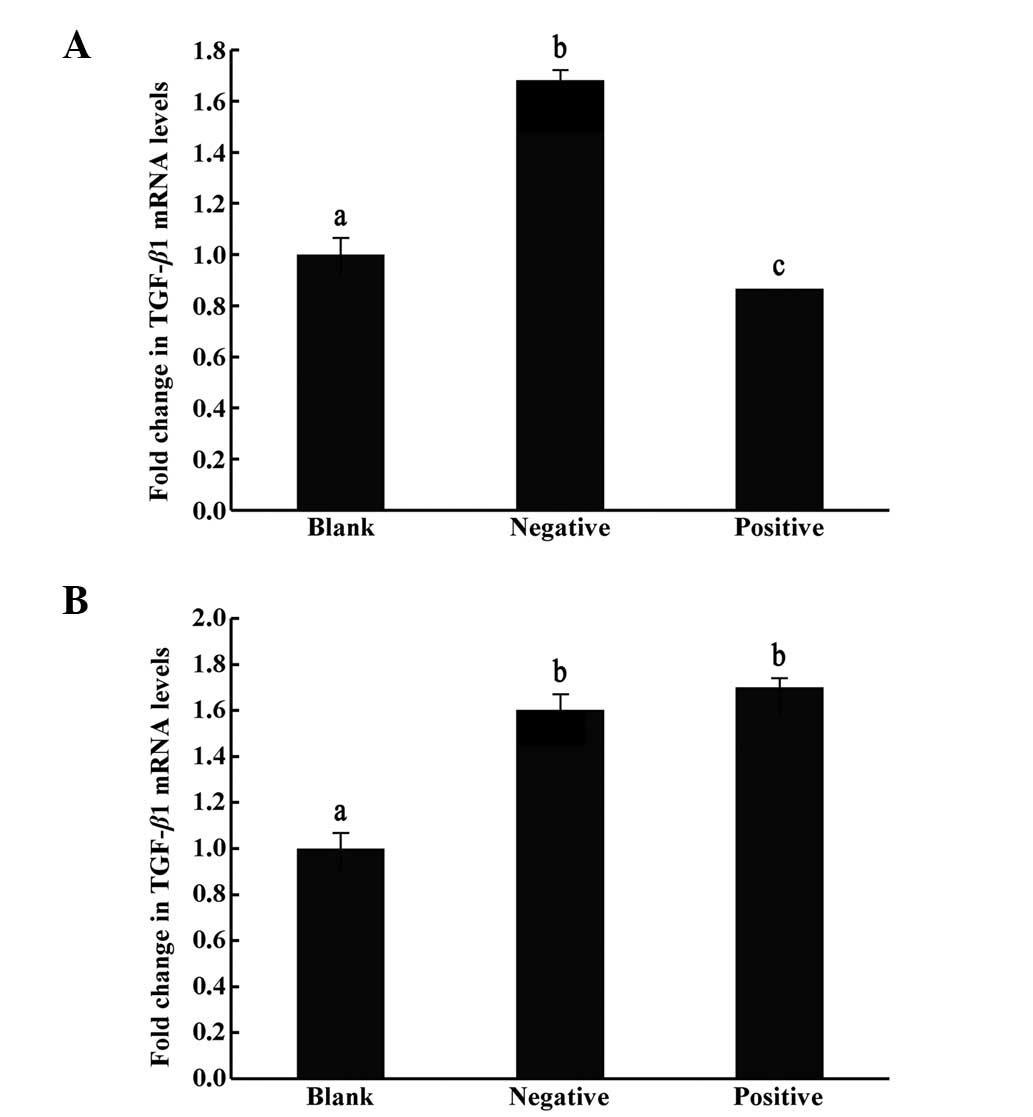Transforming growth factor-β1 small interfering RNA inhibits growth of human embryonic lung fibroblast HFL-I cells in vitro and defends against radiation-induced lung injury in vivo
- Authors:
- Published online on: November 11, 2014 https://doi.org/10.3892/mmr.2014.2923
- Pages: 2055-2061
Abstract
Introduction
Radiation-induced lung injury typically presents with two distinct subsequent clinical phases, interstitial pneumonia and fibrosis, which frequently occur following completion of radiation therapy for thoracic neoplasia. This complex process is regulated by mutually dependent cellular lineages and a multitude of biologically active molecules. Transforming growth factor-β1 (TGF-β1) is an important growth factor among the molecules that are expressed in tissues following radiation exposure and a positive correlation has been observed between the severity of radiation-induced lung injury and TGF-β1 signal activation (1,2). Lung fibroblasts are one of the main cells in which TGF-β1 is highly expressed, thus injury may be prevented by inhibiting the expression of TGF-β1. Since its identification by Fire et al (3), RNA interference (RNAi) has been used to guide sequence-specific gene silencing of target mRNAs.
In the present study, the RNAi strategy was used to downregulate TGF-β1 by constructing a small interfering RNA (siRNA) plasmid vector, termed TGF-β1-siRNA. The effects of TGF-β1-siRNA on the proliferation and differentiation of lung fibroblast, HFL-I, cells the intervention effects of the expression vector on the radiation-induced lung injury were then investigated. The aim of the present study was to identify effective treatment options to assist in the prevention and/or management of radiation-induced lung injury.
Materials and methods
Construction of the TGF-β1-siRNA expression vector
According to Reynolds et al (4), three synthetic siRNAs targeting human TGF-β1 mRNA (GenBank accession no. NM000660), with a length of 19–21 nucleotides, were synthesized by GenePharma Co., Ltd. (Shanghai, China), of which one effective siRNA sequence (5′-GCAGAGTACACACAGCATA-3′) was adopted for the subsequent experiments.
In vitro experiment
Cell culture and shRNA transfection
The human embryonic lung fibroblast, HFL-I, was obtained from the cell bank of the Chinese Academy of Sciences (Shanghai, China), and were maintained in F12K supplemented with 10% fetal bovine serum and antibiotics (100 U/ml penicillin G and 100 U/ml streptomycin sulfate; Gibco, Grand Island, NY, USA) at 37°C in 5% CO2. HFL-I cells were resuspended using 1 ml trypsin, and plated in six-well plates at a density of 1.2×105 cells/well. After a period of 24 h, the siRNA duplexes were mixed with Lipofectamine 2000 (Invitrogen Life Technologies, Carlsbad, CA, USA) in Opti-MEM® I reduced serum medium for 20 min at room temperature to enable complex formation. The total volume (250 μl) of transfection mixture was then added to the six-well plates, which were randomly divided into the positive interference group, which was transfected with TGF-β1-siRNA, the negative control group, which was transfected with empty vectors and the blank control group without transfection. Following 6 h incubation, the medium was replaced by 4 ml Opti-MEM® I containing 5% fetal bovine serum and the cells were incubated for another 42 h prior to harvesting for reverse transcription quantitative PCR (RT-qPCR) analysis.
RT-qPCR
The total RNA was isolated from 1×106 cells of each well using TRIzol® reagent (Invitrogen Life Technologies). Total RNA (1 μg) was reverse-transcribed into cDNA using AMV Reverse Transcriptase (Promega, Madison, WI, USA). Oligonucleotide primers were designed for the specific amplification of TGF-β1 and the internal control β-actin according to the sequences published in GenBank (Table I). Amplifications were performed using the FTC-2000 (Funglyn Biotech, Inc., Toronto, ON, Canada) sequence detection system, using SYBR-Green I (ShineGene, Shanghai, China). The thermal profile was as follows: 94°C for 4 min followed by 35 cycles of 94°C for 20 sec, 60°C for 30 sec and 72°C for 30 sec. The TGF-β1 mRNA level in each sample, relative to that of β-actin mRNA, was calculated using the 2−ΔΔCt formula. The levels of β-actin were not changed in any of the experimental conditions (Table I).
Table INucleotide sequences of primers used for quantitative polymerase chain reaction and product sizes. |
Enzyme linked immunosorbent assay (ELISA)
The supernatant of the cultured cells was collected 48 h after transfection and the concentrations of TGF-β1 were measured using an ELISA kit (R&D Systems, Inc., Minneapolis, MN, USA) according to the manufacturer’s instructions. The standard immunoreagent was diluted with sample dilution to 31.2, 62.5, 125, 250, 500, 1,000 and 2,000 ng/ml as a series multiproportion dilution. The absorbance values were determined at 450 nm using a Bio-Rad Model 450 microplate reader (Bio-Rad, Hercules, CA, USA) and a standard curve was established to calculate the concentrations of TGF-β1 accordingly.
Annexin V apoptosis detection assay
The HFL-I cells were plated onto 6-well plates at a density of 4×105/well and randomly divided into the positive interference group (transfected with TGF-β1-siRNA), negative control group (transfected with empty vectors) and control group (without transfection), with two replicates in each. Following incubation of the cells for 72 h, apoptosis was analyzed using a BD FACSAria flow cytometer (BD Biosciences, San Jose, CA, USA), using a fluorescein isothiocyanate (FITC) Annexin V/Dead Cell Apoptosis kit with FITC Annexin V and propidium iodide (Invitrogen Life Technologies).
In vivo experiment
Animals and experimental design
In total, 384 adult, female, specific-pathogen-free C57BL/6 mice (~8 weeks old), were purchased from Vital River Laboratory (Beijing, China). The mice were maintained in a cage, each containing between four and six mice, supplied with standard laboratory food and water. The mice were randomly divided into the following four groups: control without any treatment (24 mice), radiation alone (120 mice); radiation followed by transfection with empty vectors (120 mice) and radiation followed by transfection with the TGF-β1-siRNA vector (120 mice). The empty vectors and TGF-β1-siRNA vectors were transfected into the lung of the mice in the transfection groups, respectively, on days 1, 7, 14, 28 and 60 of radiation (24 mice/time point). The present study was performed in strict accordance with the recommendations in the Guide for the Care and Use of Laboratory Animals of the National Institutes of Health and the animal experimental procedures were approved by the Institutional Animal Care and Use Committee of Suzhou University (Suzhou, China).
The mice were restrained on the treatment table with specific jigs and a 23 mm thick paraffin block was placed above the thoraces of the animal to obtain an even distribution of radiation dose, using lead shields for radiation protection of the head and abdomen. A dose of 12 Gy to the entire thorax was delivered in a single fraction at the anterior field using a linear accelerator (Primus; Siemens AG, Munich, Germany). The radiation parameters were a beam energy of 6 MV, an X-ray source-surface distance of 100 cm and a field size of 10 cm2 to provide adequate coverage of the entire lung.
The irradiated mice were then anesthetized using 3.8% chloral hydrate (10 ml/kg) and fixed upright prior to injection with the specific TGF-β1-siRNA vector or empty vector (109 pfu/0.11 ml).
Sampling
A total of three mice from each group were sampled at days 2, 15 and 28 and at week 8, 12, 16, 20 and 24 of transfection. Initially, 2 ml blood was obtained immediately from the heart and placed into an anticoagulant tube containing ethylenediaminetetraacetic acid (BD Biosciences). Following standing for 30 min and centrifugation at 1,500 × g for 15 min, the serum was frozen at −70°C. The hilum of the left lung was then ligated and 4 ml physiological saline was injected following endotracheal intubation. This was then removed by suction following standing for 3 min standing and was repeated three times. Bronchoalveolar lavage fluid was collected and centrifuged at 3,000 × g for 4 min and the supernate was then stored at −70°C. The left lung was fixed in 10% formaldehyde solution (Sinopharm Chemical Reagent Co., Ltd., Shanghai, China) for 24 h, dehydrated, embedded in paraffin (Sinopharm Chemical Reagent Co., Ltd.) and sectioned on a microtome (Leica, Wetzlar, Germany). The sections were then stained with hematoxylin and eosin (H&E) and Van-Gieson (VG) (Zhongshan Golden Bridge Bio-technology, Beijing, China) for the observation of pulmonary fibrosis. In addition, the right lung was stored in liquid nitrogen.
Immunohistochemistry
Slides were deparaffinized, rehydrated though a graded series of ethanol and treated with 3% H2O2 in H2O to quench endogenous peroxidase activity. The specimens were incubated overnight at 4°C with rabbit polyclonal antibody against mouse TGF-β1 (1:100; Santa Cruz Biotechnology, Inc., Santa Cruz, CA, USA) using the ULtraSensitive™ S-P Mouse kit-9701 and was detected with diaminobenzidine staining (Fuzhou Maixin Biotechnology Co., Ltd., Fuzhou, China) used as chromogen. Subsequently, 10 randomly selected fields on each slide were observed and images were captured using an Olympus BX51 microscope image acquisition system (Olympus, Tokyo, Japan). The pulmonary interstitial surface density and integral optical density were quantified using Image-Pro Plus 6.0 software (Media Cybernetics, Silver Spring, MD, USA) and deposition of collagen in the lung tissue was observed by VG staining.
ELISA
The levels of TGF-β1 in the serum and the bronchoalveolar lavage fluid were determined using ELISA kits (R&D Systems, Minneapolis, MN, USA) according to the manufacturer’s instructions.
Statistical analysis
Data are expressed as the mean ± standard deviation. The differences between any two groups were determined by analysis of variance. P<0.05 was considered to indicate a statistically significant difference.
Results
Effects of TGF-β1-siRNA on human embryonic lung fibroblast HFL-I cells in vitro
TGF-β1 mRNA levels in HFL-I cells quantified by RT-qPCR
The relative ratios of mRNA expression of TGF-β1 between the blank control with no transfection, the negative control transfected with empty vectors and the positive interference group transfected with TGF-β1-siRNA, were significantly different (P<0.05). The expression levels of the target gene TGF-β1 were lowest in the TGF-β1-siRNA injection group, suggesting that the constructed interference plasmid exerted interference effects (Fig. 1).
TGF-β1 protein contents in the cell culture medium measured by ELISA
The contents of TGF-β1 measured in the blank control, negative control and positive interference groups were 33.8±3.8, 32.3±2.4 and 24.0±3.0 ng/ml, respectively. The levels of TGF-β1 were lowest in the positive interference group, which differed significantly from those of the other groups (P<0.05; Fig. 2).
Effect of TGF-β1-siRNA on the apoptosis of HFL-I cells measured by Annexin V
Following transfection for 72 h, the apoptotic rate of the HFL-I cells in the positive interference group (78%) was significantly higher compared with those of the negative and blank control groups (51 and 52% respectively; P<0.05), while no significant differences were observed between the negative control and the blank control groups (Fig. 3).
Effects of TGF-β1-siRNA on radiation-induced lung injury in vivo
General conditions of the experimental mice
All the mice were weighed every 2 weeks following radiation, which were between 19 and 25 g. The mice were in good condition with normal tail-lift reflection and no hair loss, skin edema or rupture was observed in the irradiated area. The respiratory frequencies of the irradiated mice without transfection increased significantly to 165±13 breaths/min (~80%) in the eighth week, compared with the control group without any treatment and the result was similar in the irradiated mice transfected with empty vectors. In the mice transfected with TGF-β1-siRNA, the respiratory frequencies increased significantly from the 1st day of radiation to 125±5 breaths/min (~20%) in the 10th week (P<0.01), compared with the control and no dyspnea observed (Fig. 4).
Histopathological changes of the lung
Normal lung morphology was observed in the control mice following H&E staining. In the irradiated mice without transfection, thickened alveolar walls, hemangiectasis, hyperemia of the pulmonary capillaries and a low level of inflammatory cell infiltration were observed on the second day of radiation. Focal inflammatory infiltration was observed from day 15 onward and pulmonary edema with local pulmonary consolidation became more marked in the week 8 and 12 of radiation (Fig. 5A–D). The levels of inflammation and edema were less marked in the mice transfected with TGF-β1-siRNA on the first day of radiation (Fig. 5E–H). Compared with that of the control without any treatment, the surface density of pulmonary interstitial collagen fibres in mice without transfection and mice transfected with empty vectors increased gradually in the 4th and 8th weeks of radiation (P<0.05), which was significantly reduced in the TGF-β1-siRNA transfection group (P<0.05; Table II). The VG staining revealed that the dunkelrosa collagens in mice transfected with TGF-β1-siRNA, distributed mainly in the airway and vascular adventitia, were reduced compared with those in the irradiated mice without transfection on the 2nd and 15th days of radiation. From the 4th week of radiation onwards, collagen fibers in the vascular adventitia and the alveolar septum were increased in mice without transfection, which was allayed to some extent in the TGF-β1-siRNA transfected mice (Fig. 5I–K). Furthermore, compared with mice transfected with TGF-β1-siRNA at the later phases of radiation (28th day; Fig. 5J), fewer collagen fibers were observed in the vascular adventitia and the alveolar septum in mice transfected with TGF-β1-siRNA earlier (7th day; Fig. 5I).
Table IIVariations in the surface density of pulmonary interstitial collagen fibers and the TGF-β1 staining intensity positive for radiation-induced lung injury. |
Immunohistochemistry
Few areas of TGF-β1 positive reaction were detected in the alveolar septum, fine bronchial smooth muscle, vascular smooth muscle, endothelium and vascular surroundings of the control lung tissue, suggesting that the expression of TGF-β1 is normally weak or absent. In the irradiated mice without transfection, radiation for 4 and 8 weeks significantly enhanced the expression of TGF-β1 in the above-mentioned regions and, in particular, high levels of expression were found in the alveolar epithelial cells and pulmonary interstitial macrophages. Compared with this group, the positive area in the TGF-β1-siRNA transfected mice was markedly decreased (P<0.05; Table II).
Levels of TGF-β1 in the serum and bronchoalveolar lavage fluid measured by ELISA
Changes in the levels of TGF-β1 in the serum and bronchoalveolar lavage fluid were almost in accordance with the histopathological changes observed in the lung tissues. Specifically, the levels of TGF-β1 in the serum of irradiated mice without transfection increased with time, which increased significantly 4 weeks and peaked 8 weeks after radiation, compared with the control (P<0.05). The levels of TGF-β1 in the serum of irradiated mice transfected with TGF-β1-siRNA also increased gradually, however it differed significantly compared with that in the mice irradiated without transfection (P<0.05). Changes in the levels of TGF-β1 in the bronchoalveolar lavage fluid were similar with that in the serum, however, a reduction was observed following the peak in the fourth week of radiation (Table III).
Changes in mRNA expression levels of TGF-β1 quantified by RT-qPCR
Following radiation, the mRNA expression of TGF-β1 was significantly upregulated in mice without any transfection and in those transfected with empty vectors, compared with the control (P<0.05). In general, the mRNA expression levels of TGF-β1 in mice transfected with TGF-β1-siRNA were markedly lower compared with those in the mice without transfection or in those transfected with empty vectors. This difference was significant in the fourth, eighth, 12th and 16th week of radiation (P<0.05). The mRNA expression of TGF-β1 was upregulated from the 8th week of radiation, peaked at the 12th week and was then downregulated. Notably, in the 12th week of radiation, the mRNA expression levels of TGF-β1 were highest in the radiated non-transfection group, followed by the TGF-β1-siRNA transfection group and then the controls (Fig. 6). Furthermore, the mRNA expression levels of TGF-β1 were lower in mice transfected with TGF-β1-siRNA (Fig. 7A) on the first day following radiation compared with those transfected with TGF-β1-siRNA at later phases of radiation (28th day; Fig. 7B).
Discussion
Radiation-induced lung injury is one of the most common complications following thoracic radiochemotherapy, of which radiation pneumonitis and pulmonary fibrosis represent acute and late phases, respectively. It can markedly decrease the quality of life and even the life span of patients with a thoracic tumor. This injury may be induced by various factors, involving the injured cells targeted by radiation and profibrotic cytokines produced by damaged and activated cells (5). In the later phases, cytokine-mediated proliferation, activation and differentiation of fibroblasts into myofibroblasts occur with associated collagen deposition, which may cause respiratory failure. Currently, several pharmaceuticals are used in the management of radiation pneumonitis in the early phase, including glucocorticoids, non-steroidal anti-inflammatory drugs, adjuvant interferon R and other drugs, which relieve lung injury. However, the formation of a mass of pulmonary fibrosis remains possible in the late phase.
Previous investigations have demonstrated that between a few hours and a few days following radiation, quantities of growth factors are synthesized and secreted, which continues for several months. These early changes have profound impacts on pathological and physiological changes in the late phase. Cytokines including TGF-β1, platelet-derived growth factor (PDGF), tumor necrosis factor-α (TNF-α), interleukin-1 (IL-1) and insulin-like growth factor-1 are involved in pulmonary fibrosis, by which multi-cellular interactions are mediated to initiate and maintain the process of fibrosis. TGF-β1, one of the factors regulating the growth of various human epithelial cells, has a wide range of biological effects on cell growth, differentiation, extracellular matrix deposition and immune response (6). TGF-β1 is considered to be closely associated with the formulation and maintenance of radiation pulmonary fibrosis, since increased levels of TGF-β1 are detected in pulmonary fibrosis induced by bleomycin, cyclophosphamide and radiation (7–10). TGF-β1 stimulates the synthesis of IL-1, TNF-α and PDGF by inflammatory cells or fibroblast, suggesting the importance of this factor in the cytokine network, while its own production also exists in an autocrine manner. TGF-β1 is also responsible for the regulation of extracellular matrix (ECM) by two different mechanisms (2). It enhances ECM synthesis by inducing the synthesis of collagen and various other extracellular matrix components, including fibronectin and it can reduce ECM degradation, partially by inhibiting the expression of proteolytic enzyme. Chiang et al (11) reported that in mice receiving radiation, pulmonary fibrosis or subacute radiation pneumonia develops and TGF-β1 is upregulated, particularly in the late phases of pulmonary fibrosis.
Understanding the molecular mechanisms and signaling pathways of radiation-induced lung injury make it possible to intervene and prevent this injury by using certain biological techniques similar to anticytokine therapy, which has been utilized as a novel treatment to inhibit pulmonary fibrosis. Considering the important roles of TGF-β1 in the development of fibrosis induced by radiation, matrix generation may be inhibited and matrix degradation may be stimulated by suppressing the activity of TGF-β1 in antifibrotic therapy. As RNAi relies on the sequence-specific interaction between siRNAs and mRNA, siRNAs can be tailored to silence almost any gene. It is one of the important mechanisms in post-transcriptional gene silencing in eukaryotes. The central process of RNAi is the cleavage of dsRNA into smaller fragments of a defined length (~21–23 nucleotides) by the enzyme Dicer. RNAi has been widely used for the analysis of gene function and signal transduction, representing a potentially promising approach for gene therapy. It has been reported that the inhibitory effect of siRNA synthesized via a plasmid or viral vector on the target gene is similar with that of synthetic siRNA (12).
In the present study, sequence-specific siRNA targeting TGF-β1 mRNA was constructed and transfected into human embryonic lung fibroblast HFL-I cells. The target oligonucleotide fragments were confirmed to have been cloned into the pRNAT plasmid vector, as expected using an enzyme digestion and sequence reaction. Compared with the control group, the mRNA expression and protein levels of TGF-β1 were found to be significantly inhibited by qPCR and ELISA, respectively. The results of the Annexin V apoptosis detection assay suggested that the marked increase in HFL-I cell apoptosis was caused by TGF-β1-siRNA transfection. Taken altogether, the constructed TGF-β1-siRNA plasmid demonstrated significant interference effects in vitro.
The in vivo investigation further demonstrated that radiation significantly elevated the mRNA expression and protein levels of TGF-β1 in the lung of mice, indicating that TGF-β1 is important in the genesis and development of radiation-induced lung injury. Previous studies have demonstrated that lung fibrosis is inhibited by inhibiting the TGF-β1 signaling pathway or the application of TGF-β1 monoclonal antibodies (13). In the present study, the above-mentioned functional TGF-β1-siRNA was used in a rodent model of radiation-induced lung injury. The results revealed that radiation-induced pulmonary edema and alveolar inflammation were significantly relieved and the mRNA expression levels of TGF-β1 were downregulated in the irradiated mice transfected with TGF-β1-siRNA compared with the irradiated mice without transfection or transfected with empty vectors. These results suggested that the TGF-β1-siRNA vector had protective effects against radiation-induced lung injury, possibly by inhibiting the expression of TGF-β1. In conclusion, the specific TGF-β1-siRNA vector effectively reduced the expression of TGF-β1 and thereby inhibited the inflammatory response during radiation-induced pulmonary injury, which may assist in identifying novel techniques to prevent radiation-induced lung injury and fibrosis.
Acknowledgements
This study was funded by the Natural Science Foundation of Jiangsu Province (no. BK2009102), the National Natural Science Foundation of China (nos. 81402518 and 81472920), the Jiangsu Provincial Special Program of Medical Science (no. BL2012046), the Changzhou Scientific Program (nos. ZD200818, CE20125026, CE20135050, CJ20112019 and ZD201315) and the Open Program of Jiangsu Provincial Key Laboratory of Radiation Medicine and Protection (nos. KJS1241 and KJS1242).
References
|
Anscher MS, Marks LB, Shafman TD, et al: Risk of long-term complications after TFG-beta1-guided very-high-dose thoracic radiotherapy. Int J Radiat Oncol Biol Phys. 56:988–995. 2003. View Article : Google Scholar : PubMed/NCBI | |
|
Novakova-Jiresova A, Van Gameren MM, Coppes RP, Kampinga HH and Groen HJ: Transforming growth factor-beta plasma dynamics and post-irradiation lung injury in lung cancer patients. Radiother Oncol. 71:183–189. 2004. View Article : Google Scholar : PubMed/NCBI | |
|
Fire A, Xu S, Montgomery MK, Kostas SA, Driver SE and Mello CC: Potent and specific genetic interference by double stranded RNA in Caenorhabditis elegans. Nature. 391:806–811. 1998. View Article : Google Scholar : PubMed/NCBI | |
|
Reynolds A, Leake D, Boese Q, Scaringe S, Marshall WS and Khvorova A: Rational siRNA design for RNA interference. Nat Biotechnol. 22:326–330. 2004. View Article : Google Scholar : PubMed/NCBI | |
|
Schallenkamp JM, Miller RC, Brinkmann DH, Foote T and Garces YI: Incidence of radiation pneumonitis after thoracic irradiation: Dose volume correlates. Int J Radiat Oncol Biol Phys. 67:410–416. 2007. View Article : Google Scholar : PubMed/NCBI | |
|
Kim SH, Lim DJ, Chung YG, Cho TH, Lim SJ, Kim WJ and Suh JK: Expression of TNF-alpha and TGF-beta 1 in the rat brain after a single high-dose irradiation. J Korean Med Sci. 17:242–248. 2002. View Article : Google Scholar : PubMed/NCBI | |
|
Evans ES, Kocak Z, Zhou SM, et al: Does transforming growth factor beta1 predict for radiation induced pneumonitis in patients treated for lung cancer. Cytokine. 35:186–192. 2006. View Article : Google Scholar : PubMed/NCBI | |
|
Chen Y, Williams J, Ding I, et al: Radiation pneumonitis and early circulatory cytokine markers. Semin Radiat Oncol. 12:S26–S33. 2002. View Article : Google Scholar | |
|
Nagashio Y, Ueno H, Imamura M, et al: Inhibition of transforming growth factor beta decreases pancreatic fibrosis and protects the pancreas against chronic injury in mice. Lab Invest. 84:1610–1618. 2004. View Article : Google Scholar : PubMed/NCBI | |
|
Martin M, Lefaix JL and Delanian S: TGF-beta1 and radiation fibrosis: a master switch and a specific therapeutic target? Int J Radiant Oncol Biol Phys. 47:277–290. 2000. View Article : Google Scholar | |
|
Chiang CS, Liu WC, Jung SM, et al: Compartmental responses after thoracic irradiation of mice: strain differences. Int J Radiat Oncol Biol Phys. 62:862–871. 2005. View Article : Google Scholar : PubMed/NCBI | |
|
Volarevic M, Smolic R, Wu CH and Wu GY: Potential role of RNAi in the treatment of HCV infection. Expert Rev Anti Infect Ther. 5:823–831. 2007. View Article : Google Scholar : PubMed/NCBI | |
|
Shimizukawa M, Ebina M, Narumi K, Kikuchi T, Munakata H and Nukiwa T: Intratracheal gene transfer of decorin reduces subpleural fibroproliferation induced by bleomycin. Am J Physiol Lung Cell Mol Physiol. 284:L526–L532. 2003.PubMed/NCBI |



